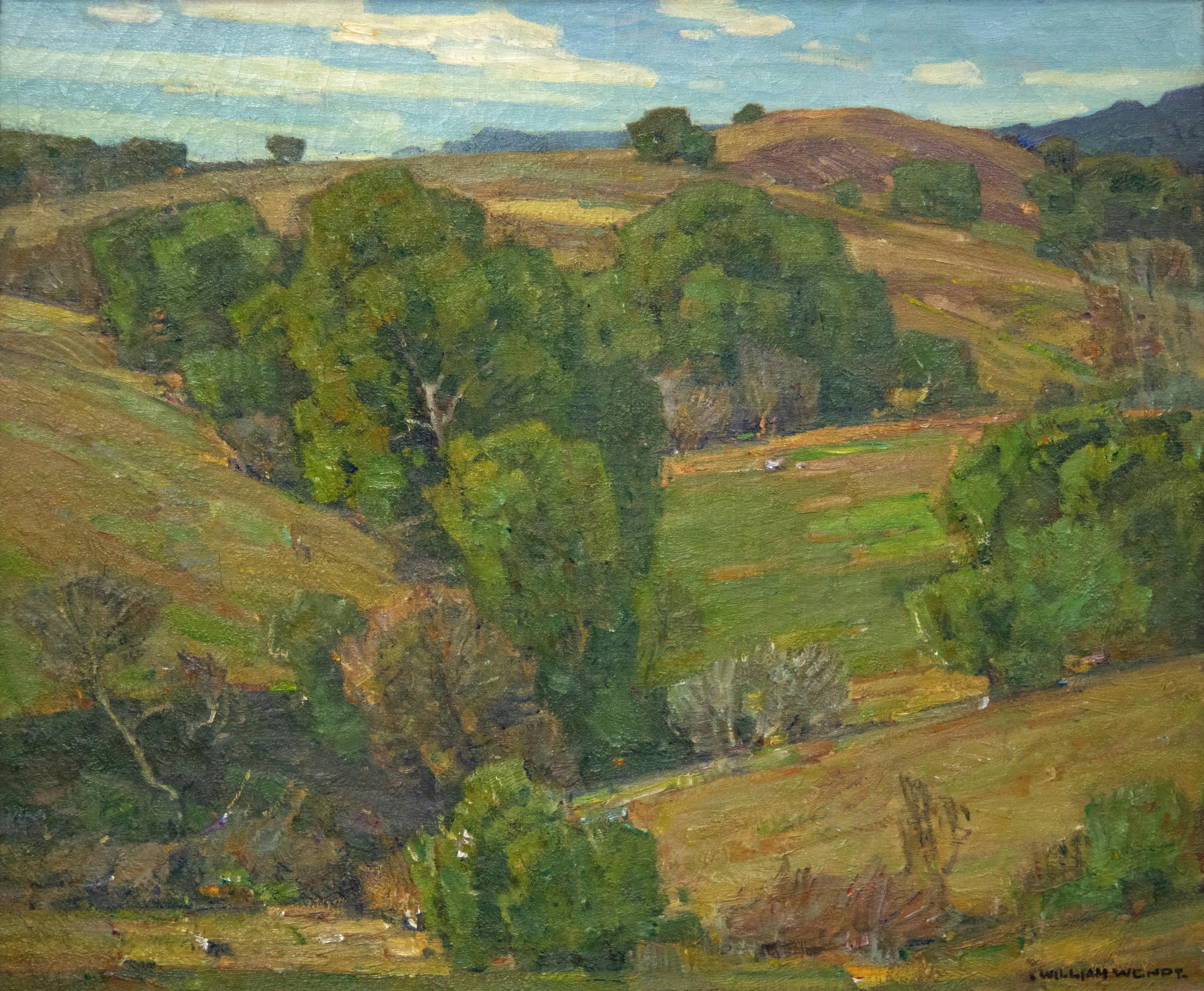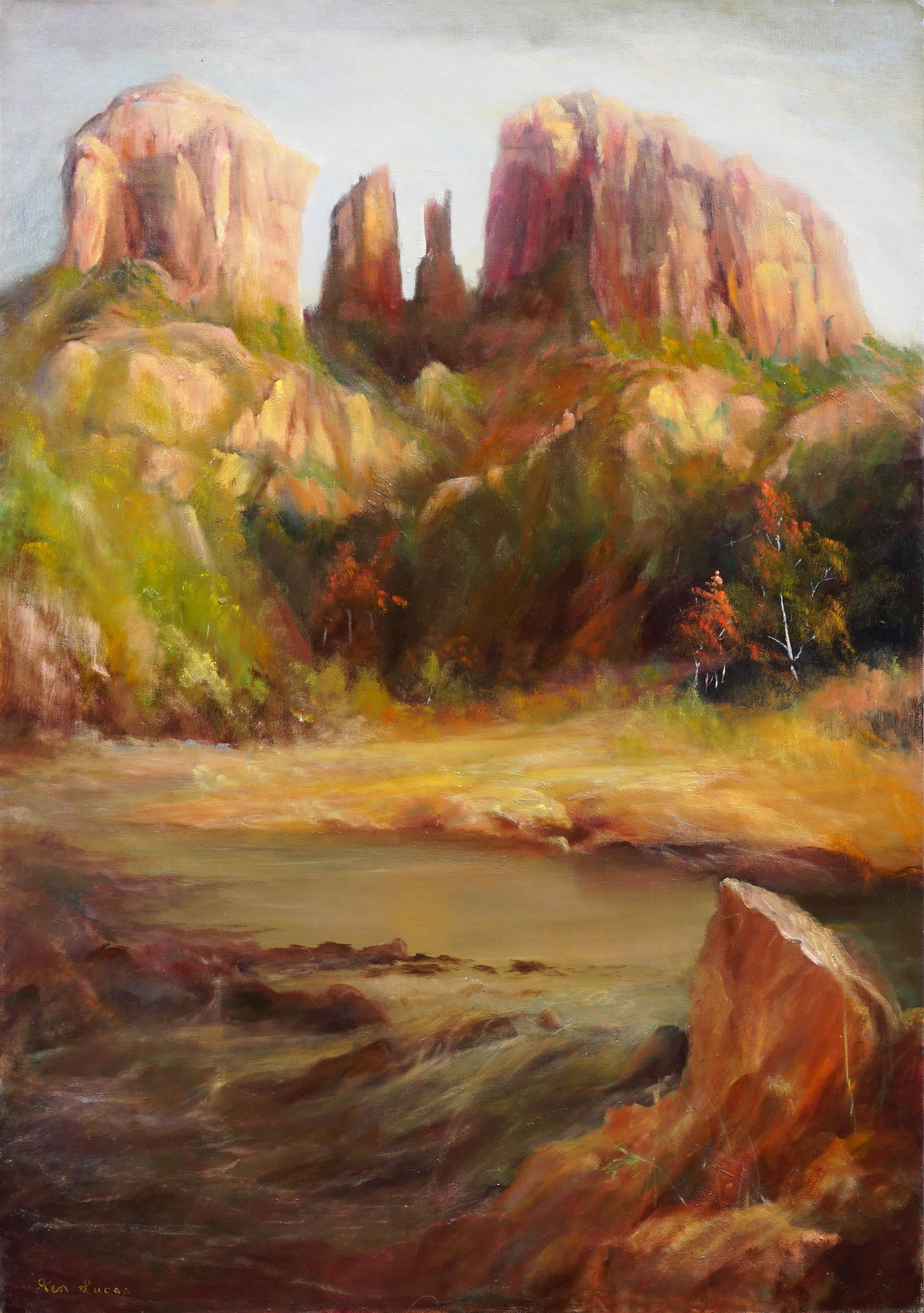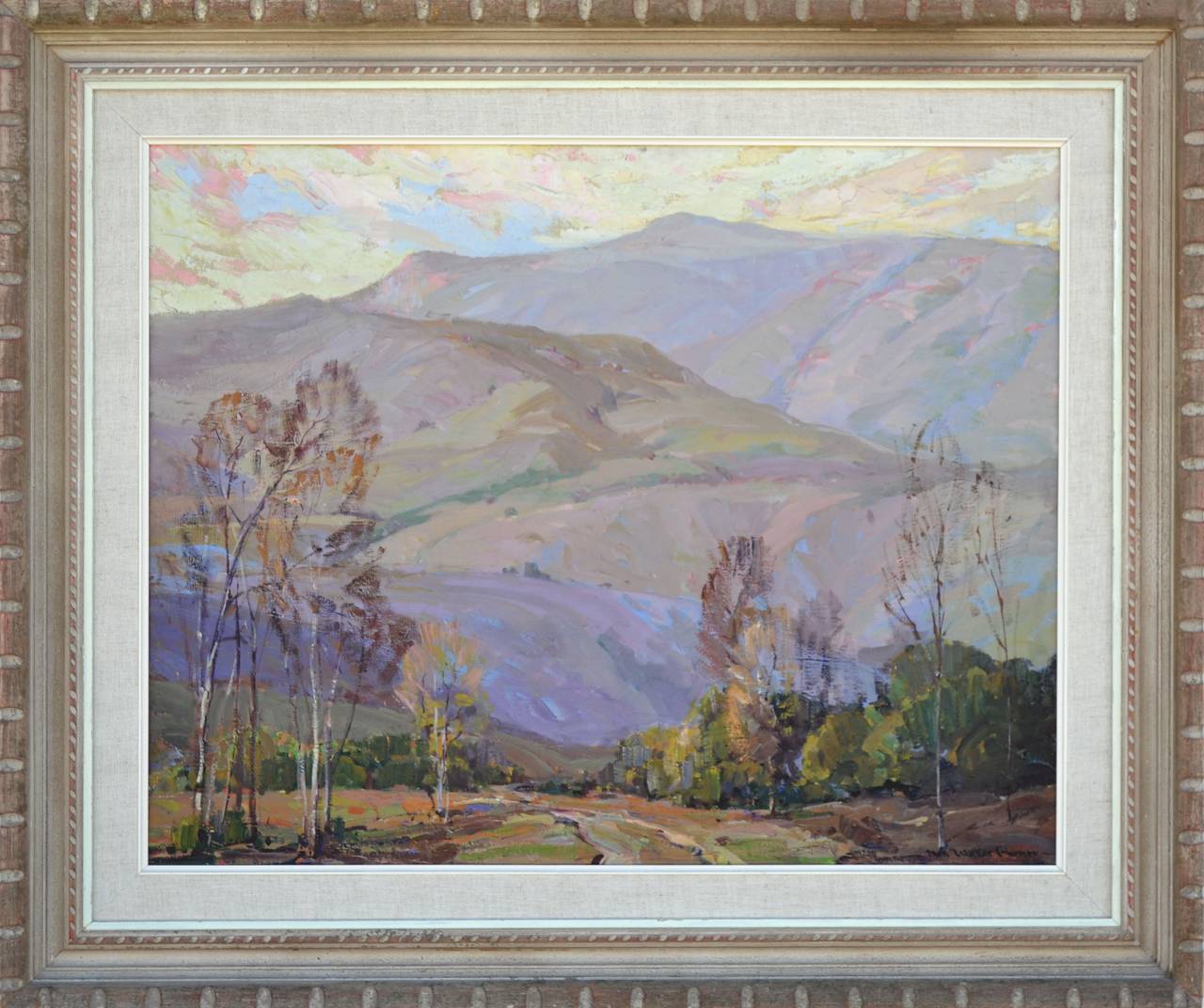Items Similar to "Spring on Risdon Street, Mt. Holly, NJ"
Want more images or videos?
Request additional images or videos from the seller
1 of 4
Hugh Campbell"Spring on Risdon Street, Mt. Holly, NJ"
About the Item
Jim’s of Lambertville is proud to offer this artwork.
Signed lower right.
Complemented by a hand carved and gilt frame.
Hugh Campbell (1905-1997)
Born December 4, 1905 in Atchison, Kansas. He moved to the Camden, New Jersey area when he was 10 years old. Hugh Campbell left a nine-to-five job in 1930's to pursue an artist's life. He jumped into his new life with nothing but determination and a "feeling" that he could paint. He had no formal training. Training himself was his first priority, which he did by drawing over 1,000,000 free-hand circles and then over 130,000 action sketches of people on the streets. But it was the fields around his boyhood fishing spots in Mount Holly where he felt the most at home.
He commuted from Camden to Mount Holly regularly as he discovered that those fields and streets were the subject matter that he wanted to paint. He had no money and no place to stay so he would pitch a tent in a field and stay overnight. At one point the owner of Hack's Canoe Retreat told him that he didn't have to pitch a tent, he could come as often as he liked and stay as long as he liked in an unheated canoe barn at no charge. He thought Hugh was going to stay a week or two, but he ended up staying seven years. In the 1940s Hugh Campbell bought an old tar paper bicycle repair shop building for $150 and moved in onto Kates Tract the woods on the banks of the Rancocas.
Hugh Campbell had a quiet, austere lifestyle. Each night, winter and summer, he would go to Milldam Park and meditate. Each day, carrying his heavy painting gear, he would roam the fields, valleys and woods up and down the Rancocas Creek and look for inspiration. Then, after painting, he would record in his voluminous diaries the goings-on all around him. Every Sunday he would display his paintings along the concrete wall on High Street for even then unheard of prices of 20 or 30 dollars. He earned, on average, an income of about $2.00 to $5.00 a week from the sale of his paintings. As he refined his technique he became a regular at the Rittenhouse Square Annual Clothesline Exhibit in Philadelphia.
- Creator:Hugh Campbell (1905 - 1981, American)
- Dimensions:Height: 43 in (109.22 cm)Width: 48 in (121.92 cm)Depth: 3 in (7.62 cm)
- Medium:
- Movement & Style:
- Period:
- Condition:
- Gallery Location:Lambertville, NJ
- Reference Number:
About the Seller
5.0
Vetted Seller
These experienced sellers undergo a comprehensive evaluation by our team of in-house experts.
Established in 1997
1stDibs seller since 2014
36 sales on 1stDibs
Typical response time: 4 hours
- ShippingRetrieving quote...Ships From: Lambertville, NJ
- Return PolicyThis item cannot be returned.
More From This SellerView All
- "Fresh Snow"By Walter Emerson BaumLocated in Lambertville, NJJim’s of Lambertville Fine Art Gallery is proud to present this piece by Walter Emerson Baum (1884 - 1956). Born in Sellersville, Pennsylvania, Walter Baum was one of the only membe...Category
20th Century American Impressionist Landscape Paintings
MaterialsCanvas, Oil
- "Spring, Oakview"By Antonio Pietro MartinoLocated in Lambertville, NJJim’s of Lambertville is proud to offer this artwork by: Antonio Pietro Martino (1902 - 1988) Signed and dated lower right. Complemented by a period frame. Antonio Martino was ...Category
1920s American Impressionist Landscape Paintings
MaterialsCanvas, Oil
- "Sunlit House, Centre Bridge"By Clarence Raymond JohnsonLocated in Lambertville, NJJim's of Lambertville Fine Art Gallery is proud to present this piece by Clarence Raymond Johnson (1894 - 1981). Clarence Johnson was an important New Hope School Impressionist painter who was active from 1917 until 1935. Born in Ohio, Johnson began his studies at the Columbus Art School. He then came to the Pennsylvania Academy of the Fine Arts where he studied under Daniel Garber, Emil Carlsen, and Cecilia Beaux...Category
1920s American Impressionist Landscape Paintings
MaterialsCanvas, Oil
- "The Canal"By Edward Willis RedfieldLocated in Lambertville, NJJim’s of Lambertville is proud to offer this artwork. Signed lower left. Complemented by a hand carved and gilt frame. Illustrated in "Edward Redfield: Just Values and Fine Seeing" by Constance Kimmerle and the Pennsylvania Academy of the Fine Arts's Exhibition of Paintings by Edward Redfield (April 17 to May 16, 1909) brochure Edward Willis Redfield (1869 - 1965) Edward W. Redfield was born in Bridgeville, Delaware, moving to Philadelphia as a young child. Determined to be an artist from an early age, he studied at the Spring Garden Institute and the Franklin Institute before entering the Pennsylvania Academy from 1887 to 1889, where he studied under Thomas Anshutz, James Kelly, and Thomas Hovenden. Along with his friend and fellow artist, Robert Henri, he traveled abroad in 1889 and studied at the Academie Julian in Paris under William Bouguereau and Tony Robert-Fleury. While in France, Redfield met Elise Deligant, the daughter of an innkeeper, and married in London in 1893. Upon his return to the United States, Redfield and his wife settled in Glenside, Pennsylvania. He remained there until 1898, at which time he moved his family to Center Bridge, a town several miles north of New Hope along the Delaware River. Redfield painted prolifically in the 1890s but it was not until the beginning of the twentieth century that he would develop the bold impressionist style that defined his career. As Redfield’s international reputation spread, many young artists gravitated to New Hope as he was a great inspiration and an iconic role model. Edward Redfield remained in Center Bridge throughout his long life, fathering his six children there. Around 1905 and 1906, Redfield’s style was coming into its own, employing thick vigorous brush strokes tightly woven and layered with a multitude of colors. These large plein-air canvases define the essence of Pennsylvania Impressionism. By 1907, Redfield had perfected his craft and, from this point forward, was creating some of his finest work. Redfield would once again return to France where he painted a small but important body of work between 1907 and 1908. While there, he received an Honorable Mention from the Paris Salon for one of these canvases. In 1910 he was awarded a Gold Medal at the prestigious Buenos Aires Exposition and at the Panama-Pacific Exposition of 1915 in San Francisco, an entire gallery was dedicated for twenty-one of his paintings. Since Redfield painted for Exhibition with the intent to win medals, his best effort often went into his larger paintings. Although he also painted many fine smaller pictures, virtually all of his works were of major award-winning canvas sizes of 38x50 or 50x56 inches. If one were to assign a period of Redfield’s work that was representative of his “best period”, it would have to be from 1907 to 1925. Although he was capable of creating masterpieces though the late 1940s, his style fully matured by 1907 and most work from then through the early twenties was of consistently high quality. In the later 1920s and through the 1930s and 1940s, he was like most other great artists, creating some paintings that were superb examples and others that were of more ordinary quality. Redfield earned an international reputation at a young age, known for accurately recording nature with his canvases and painting virtually all of his work outdoors; Redfield was one of a rare breed. He was regarded as the pioneer of impressionist winter landscape painting in America, having few if any equals. Redfield spent summers in Maine, first at Boothbay Harbor and beginning in the 1920s, on Monhegan Island. There he painted colorful marine and coastal scenes as well as the island’s landscape and fishing shacks. He remained active painting and making Windsor style furniture...Category
Early 1900s American Impressionist Landscape Paintings
MaterialsCanvas, Oil
- "In Port"By Edward Willis RedfieldLocated in Lambertville, NJJim’s of Lambertville is proud to offer this artwork by: Edward Willis Redfield (1869 - 1965) Edward W. Redfield was born in Bridgeville, Delaware, moving to Philadelphia as a young child. Determined to be an artist from an early age, he studied at the Spring Garden Institute and the Franklin Institute before entering the Pennsylvania Academy from 1887 to 1889, where he studied under Thomas Anshutz, James Kelly, and Thomas Hovenden. Along with his friend and fellow artist, Robert Henri, he traveled abroad in 1889 and studied at the Academie Julian in Paris under William Bouguereau and Tony Robert-Fleury. While in France, Redfield met Elise Deligant, the daughter of an innkeeper, and married in London in 1893. Upon his return to the United States, Redfield and his wife settled in Glenside, Pennsylvania. He remained there until 1898, at which time he moved his family to Center Bridge, a town several miles north of New Hope along the Delaware River. Redfield painted prolifically in the 1890s but it was not until the beginning of the twentieth century that he would develop the bold impressionist style that defined his career. As Redfield’s international reputation spread, many young artists gravitated to New Hope as he was a great inspiration and an iconic role model. Edward Redfield remained in Center Bridge throughout his long life, fathering his six children there. Around 1905 and 1906, Redfield’s style was coming into its own, employing thick vigorous brush strokes tightly woven and layered with a multitude of colors. These large plein-air canvases define the essence of Pennsylvania Impressionism. By 1907, Redfield had perfected his craft and, from this point forward, was creating some of his finest work. Redfield would once again return to France where he painted a small but important body of work between 1907 and 1908. While there, he received an Honorable Mention from the Paris Salon for one of these canvases. In 1910 he was awarded a Gold Medal at the prestigious Buenos Aires Exposition and at the Panama-Pacific Exposition of 1915 in San Francisco, an entire gallery was dedicated for twenty-one of his paintings. Since Redfield painted for Exhibition with the intent to win medals, his best effort often went into his larger paintings. Although he also painted many fine smaller pictures, virtually all of his works were of major award-winning canvas sizes of 38x50 or 50x56 inches. If one were to assign a period of Redfield’s work that was representative of his “best period”, it would have to be from 1907 to 1925. Although he was capable of creating masterpieces though the late 1940s, his style fully matured by 1907 and most work from then through the early twenties was of consistently high quality. In the later 1920s and through the 1930s and 1940s, he was like most other great artists, creating some paintings that were superb examples and others that were of more ordinary quality. Redfield earned an international reputation at a young age, known for accurately recording nature with his canvases and painting virtually all of his work outdoors; Redfield was one of a rare breed. He was regarded as the pioneer of impressionist winter landscape painting in America, having few if any equals. Redfield spent summers in Maine, first at Boothbay Harbor and beginning in the 1920s, on Monhegan Island. There he painted colorful marine and coastal scenes as well as the island’s landscape and fishing shacks. He remained active painting and making Windsor style furniture...Category
Early 1900s American Impressionist Landscape Paintings
MaterialsCanvas, Oil
- "The Shepaug"By John Fulton FolinsbeeLocated in Lambertville, NJJim's of Lambertville Fine Art Gallery is proud to present this piece by John Fulton Folinsbee (1892 - 1972). One of the finest painters to embark upon the New Hope Art Colony, John...Category
1910s American Impressionist Landscape Paintings
MaterialsCanvas, Oil
You May Also Like
- Laguna HillsBy William WendtLocated in Palm Desert, CAA painting by William Wendt. "Laguna Hills" is an impressionist landscape, oil on canvas in an earth-tone palette by American artist William Wendt. The artwork is signed in the lower...Category
Early 20th Century American Impressionist Landscape Paintings
MaterialsOil, Canvas
- Picnic ShadeBy Donald S. VogelLocated in Dallas, TXDonald Vogel’s paintings reflect his interest in seeking beauty in life and in sharing pleasure with his viewers. Vogel entreats us to "rejoice and celebrate each new day, knowing it...Category
1980s American Impressionist Figurative Paintings
MaterialsCanvas, Oil
- "Boats", Impressionist Oil Painting by Stanley SobossekBy Stanley SobossekLocated in Long Island City, NYArtist: Stanley Sobossek, American (1918 - 1996) Title: Boats Medium: Oil on Canvas, signed l.l. Size: 30 x 40 inches Frame Size: 38 x 46 inchesCategory
1960s American Impressionist Landscape Paintings
MaterialsOil, Canvas
- Jess Panda, SketchBy Ben FenskeLocated in Sag Harbor, NYA contemporary oil painting of a woman stepping out of her small car, a Fiat Panda. Painted from life, shadows are purple and atmospheric. She's parked on bright green grass, in rura...Category
21st Century and Contemporary American Impressionist Landscape Paintings
MaterialsCanvas, Oil
- Sedona Red Rocks, Southwestern Desert LandscapeBy Kenneth LucasLocated in Soquel, CASweeping vertical desert landscape with a calm river in the foreground and the gorgeous formations of Sedona red rocks towering above in the distance, by California artist Ken Lucas ...Category
1990s American Impressionist Landscape Paintings
MaterialsOil, Illustration Board, Canvas
- Mid Century Southern California Santa Paula Mtns Landscape, Nell Walker WarnerBy Nell Walker WarnerLocated in Soquel, CAMid Century Southern California Santa Paula Mountains Landscape by Nell Walker Warner Gorgeous mid-century landscape oil painting of Southern California's...Category
1950s American Impressionist Landscape Paintings
MaterialsCanvas, Oil



